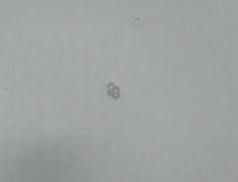.gif)
Tetrad (genetics)
Encyclopedia
The tetrad is the four spore
s of a yeast
or Chlamydomonas
, that separate after mating. If the two parents have a mutation in two different genes, the tetrad can segregate as the parental ditype (PD
), the non-parental ditype (NPD
) or as the tetratype (TT).

between the two genes.
s. Use of modern microscopy
and micromanipulation
techniques allows the four haploid spores of a yeast tetrad to be separated and germinated individually to form isolated spore colonies.
.
between the agar
and the needle.
Spore
In biology, a spore is a reproductive structure that is adapted for dispersal and surviving for extended periods of time in unfavorable conditions. Spores form part of the life cycles of many bacteria, plants, algae, fungi and some protozoa. According to scientist Dr...
s of a yeast
Yeast
Yeasts are eukaryotic micro-organisms classified in the kingdom Fungi, with 1,500 species currently described estimated to be only 1% of all fungal species. Most reproduce asexually by mitosis, and many do so by an asymmetric division process called budding...
or Chlamydomonas
Chlamydomonas
Chlamydomonas is a genus of green algae. They are unicellular flagellates. Chlamydomonas is used as a model organism for molecular biology, especially studies of flagellar motility and chloroplast dynamics, biogenesis, and genetics...
, that separate after mating. If the two parents have a mutation in two different genes, the tetrad can segregate as the parental ditype (PD
PD
-Political parties:*Democratic Party of Albania *Democratic Party *Democratic Liberal Party *Democratic Party...
), the non-parental ditype (NPD
NPD
NPD may refer to:* National Democratic Party of Germany, a far-right political party in Germany; after its German language name, Nationaldemokratische Partei Deutschlands...
) or as the tetratype (TT).

Parental ditype
A tetrad type containing two different genotypes, both of which are parental. A spore arrangement in Ascomycetes that contains only the two non-recombinant-type ascospores.Non-parental ditype
A non-parental ditype (NPD) is a spore arrangement in that contains only the two recombinant-type ascospores (assuming two segregating loci). A tetrad type containing two different genotypes, both of which are recombinant.Tetratype
A Tetratype is a tetrad containing four different genotypes, two parental and two recombinant. A spore arrangement in Ascomycetes that consists of two parental and two recombinant spores indicates a single crossover between two linked loci.Linkage analysis
The ratio between the different types arising after the sporulation is a measure of the linkageGenetic linkage
Genetic linkage is the tendency of certain loci or alleles to be inherited together. Genetic loci that are physically close to one another on the same chromosome tend to stay together during meiosis, and are thus genetically linked.-Background:...
between the two genes.
Tetrad Dissection
Tetrad Dissection has become a powerful tool of yeast geneticists, and is used in conjunction with the many established procedures utilizing the versatility of yeasts as model organismModel organism
A model organism is a non-human species that is extensively studied to understand particular biological phenomena, with the expectation that discoveries made in the organism model will provide insight into the workings of other organisms. Model organisms are in vivo models and are widely used to...
s. Use of modern microscopy
Microscopy
Microscopy is the technical field of using microscopes to view samples and objects that cannot be seen with the unaided eye...
and micromanipulation
Micromanipulator
A micromanipulator is a device which is used to physically interact with a sample under a microscope, where a level of precision of movement is necessary that cannot be achieved by the unaided human hand...
techniques allows the four haploid spores of a yeast tetrad to be separated and germinated individually to form isolated spore colonies.
Uses
Tetrad analysis can be used to confirm whether a phenotype is caused by a specific mutation, construction of strains, and for investigating gene interaction.General Procedure
Crosses are performed between haploid MATa and MATα mating strains, then the resulting diploids are transferred to sporulation media to form a tetrad containing four haploid spores. Tetrads can then be prepared with Zymolyase, or another enzyme, to digest the wall of the ascus. The spores are then separated with a micromanipulator needle and deposited in separate positions on a petri dishPetri dish
A Petri dish is a shallow glass or plastic cylindrical lidded dish that biologists use to culture cells or small moss plants. It was named after German bacteriologist Julius Richard Petri, who invented it when working as an assistant to Robert Koch...
.
Tools
Traditionally, tetrad dissection has a reputation as "dark art" . However, instruments have since been developed specifically for tetrad dissection; the most advanced allow easy and semi-automated separation of tetradshttp://www.singerinstruments.co.uk . Most micromanipulators use a fiberglass needle to which the spores adhere due to the formation of a water meniscusMeniscus
The meniscus is the curve in the upper surface of a liquid close to the surface of the container or another object, caused by surface tension. It can be either convex or concave. A convex meniscus occurs when the molecules have a stronger attraction to each other than to the material of the...
between the agar
Agar
Agar or agar-agar is a gelatinous substance derived from a polysaccharide that accumulates in the cell walls of agarophyte red algae. Throughout history into modern times, agar has been chiefly used as an ingredient in desserts throughout Asia and also as a solid substrate to contain culture medium...
and the needle.
External links
- http://www-rcf.usc.edu/~forsburg/diploids.html

